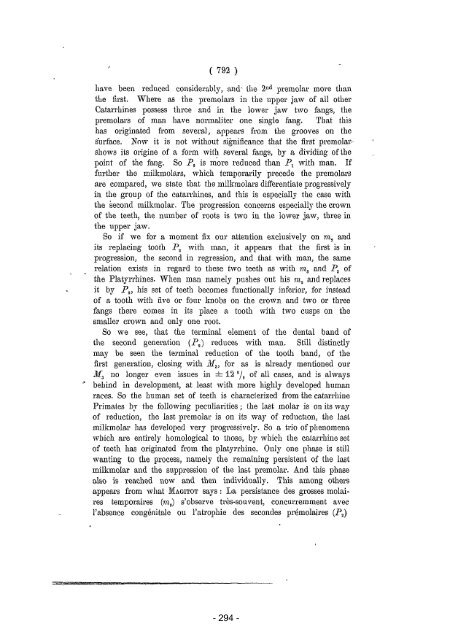Proceedings of the section of sciences - DWC - KNAW
Proceedings of the section of sciences - DWC - KNAW
Proceedings of the section of sciences - DWC - KNAW
You also want an ePaper? Increase the reach of your titles
YUMPU automatically turns print PDFs into web optimized ePapers that Google loves.
( 792 )<br />
have been reduced considel'ably, and c ihe 2 nc1 prcmolar more than<br />
<strong>the</strong> first. Whel'e as <strong>the</strong> pl'ell10lars in thc uppel' jaw <strong>of</strong> all o<strong>the</strong>1'<br />
Catarrhines possess thrce and in <strong>the</strong> lowel' jaw two fangs, <strong>the</strong><br />
pl'emolal's <strong>of</strong> man have normalHer one single fango That this<br />
has originated from severa] , appcars from <strong>the</strong> grooves on <strong>the</strong><br />
s·urface. Now it is not without significance th at <strong>the</strong> fil'st pl'emolarshows<br />
its origine <strong>of</strong> a form with several fange, by a dividing <strong>of</strong> <strong>the</strong><br />
point <strong>of</strong> <strong>the</strong> fango Sa P 2 is m'ore l'educed than P 1 with man. If<br />
fm<strong>the</strong>r <strong>the</strong> milkmolars, which temporarily pl'eeede <strong>the</strong> premolars<br />
are eompared, we state that <strong>the</strong> milkmolars differentiate progressively<br />
in <strong>the</strong> group <strong>of</strong> <strong>the</strong> ca,tarrhines, and this is especially <strong>the</strong> case with<br />
<strong>the</strong> secOlld milkmolar . The progression concerns especially <strong>the</strong> erown<br />
<strong>of</strong> <strong>the</strong> teeth, <strong>the</strong> number <strong>of</strong> roots is two in <strong>the</strong> lower jaw, three in<br />
tIle uppel' jaw.<br />
So if we for a moment fix our attention exclusively on 'fn<br />
2 and<br />
its replacing tooth P with man, it appears that <strong>the</strong> first is in<br />
2<br />
progl'ession, <strong>the</strong> seeond in regression, and that with man, <strong>the</strong> same<br />
relation exists in l'egal'd to <strong>the</strong>se two teeth as with ma and Pa <strong>of</strong><br />
<strong>the</strong> Platyrrhines. When man namely pushes out his ?n 2 and l'eplaces<br />
it by P 2 , his set <strong>of</strong> teeth becomes functionally jnfel'ior, for instead<br />
<strong>of</strong> a tooth with live or four lmobs on <strong>the</strong> crown and two or three<br />
fangs <strong>the</strong>re comes in its place a tooth with two cusps on <strong>the</strong><br />
smaller erown and only one root.<br />
So we see, that <strong>the</strong> terminal element <strong>of</strong> <strong>the</strong> den tal band <strong>of</strong><br />
<strong>the</strong> second generation (P2) l'educe& with man. Still distinctly<br />
may be seen <strong>the</strong> terminal l'eduction <strong>of</strong> <strong>the</strong> tooth band, <strong>of</strong> <strong>the</strong><br />
first gen eration , closing with J.11 a , fol' as is already mentioned our<br />
Ma no longer even issues in ± 12 % <strong>of</strong> all cases, and is always<br />
... behind in development, at least with more highly developed human<br />
races. So <strong>the</strong> human set <strong>of</strong> teeth is characterized fi'om ihe catarrhine<br />
Primaies by <strong>the</strong> following peculiarities; <strong>the</strong> last mol ar is on its way<br />
<strong>of</strong> reduction, <strong>the</strong> last premolar is on its way <strong>of</strong> reduetlOn, <strong>the</strong> lasL<br />
milkmolar 11as developed very progressively. So a trio <strong>of</strong>phenomena<br />
which are entirely homologiCc.9.1 to those, by which <strong>the</strong> catarrhine set<br />
<strong>of</strong> teeth has originated from <strong>the</strong> platyrrhine. Only one phase is still<br />
wanting to <strong>the</strong> process, namely <strong>the</strong> rel1laining persistent <strong>of</strong> <strong>the</strong> last<br />
milkmolar and <strong>the</strong> sllppression <strong>of</strong> tile 1a&t premolar. And this phase<br />
a180 is reached 110W and <strong>the</strong>n indiv1dually. This among o<strong>the</strong>rs<br />
appears from what MAGlTOT says: La persistance des grosses mol aires<br />
temporaÏl'es (m 2 ) s'observe très-souvent, concurl'emment avec<br />
l'absence congénitale ou l'atrophie des secondes prémolaires (P 2 )<br />
- 294 -

















